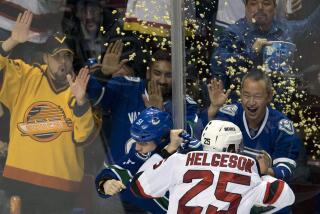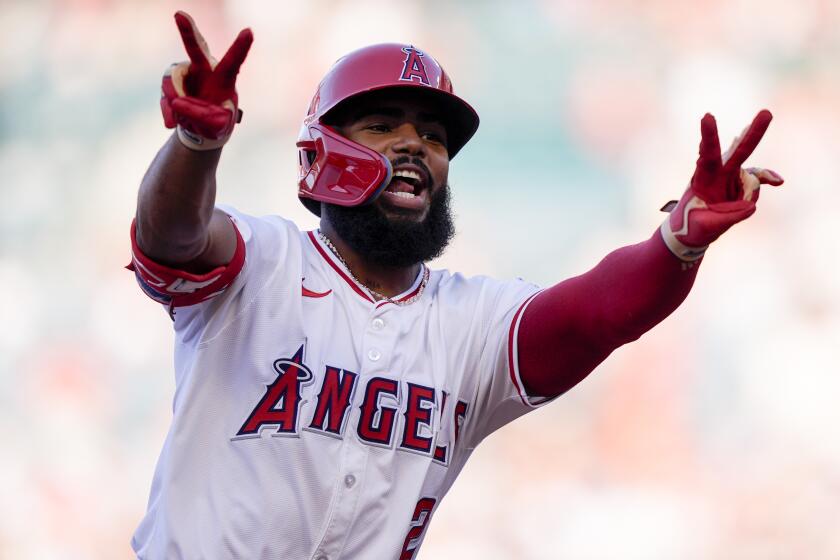The Ghost of Ace Bailey
- Share via
It had come to a point recently at the Arrowhead Pond where the absence of violence in hockey was itself a comfort. A public accustomed to the ugly side of professional sports, but weary of it, had braced for retaliation.
This was days after Dallas center Mike Modano, shoved headfirst into the boards by Duck defenseman Ruslan Salei, suffered a broken nose, concussion and strained neck. Revenge was in the air when the teams met again in Anaheim on Oct. 8. Modano made a request rare in hockey to stop the feud. To the credit of players, they didn’t exact retribution.
The nasty incidents from the sporting world add up. Only weeks before, there was an ugly exchange between the Angels and Cleveland Indians. The Angels’ Mo Vaughn refrained from jumping into a team brawl and was criticized by a teammate for his aloofness when honor supposedly was at stake.
The seasons converged as youngsters returned to the rituals of the classroom, where the lesson that two wrongs don’t make a right echoes at the kitchen table and in the Sunday school. Such guidance also must be reinforced by pro athletes, who have responsibilities as role models. Perhaps a clue to Vaughn’s character and conduct is that he has given time enthusiastically to youngsters.
All of this was in the news as two Southern California teachers returned from a tour of the country in a search to fathom youth violence. Kids, they learned in interviews in malls and housing projects, want more and better-quality attention from parents and others. They expect to know what is expected of them, which most appropriately comes from example. But for parents and teachers who are trying to pay such attention, the goon tactics in the sports world send a different message.
Closer to home, arrests of teenagers in south Orange County are up following a crackdown by the Sheriff’s Department on youth crime. Youth arrests elsewhere in the county actually are down and the same is true nationwide, even though the number of young people is higher. This complicates any post-Columbine assessments about what is happening to kids nowadays, as it does the warning from Sheriff Mike Carona of a growing crime wave as the children of baby boomers enter their teen years. Whatever conclusions are drawn from the statistics, the messages to kids in media matter. By the way, since authorities are worried about the future of the kids and are cracking down on their misbehavior, there is no reason arenas have to be exempt from law enforcement efforts in appropriate cases involving teams.
The strongest messages must come from the players, as happened when restraint ruled on Oct. 8. All of this matters because in this world of cable TV’s ubiquitous sports programming, the youngsters are getting a different electronic signal when sports violence beams into the family room. Some of the lessons to be learned turn out to be eternal verities of sport.
Before he died a few years ago, Ace Bailey, a Toronto Maple Leafs hockey star from the 1930s, watched on television too. As a much younger man in 1933 in Boston Garden, before helmets became standard fare, Bailey was hit from behind in an act of apparent retaliation by one of the legends of the game, the Boston Bruins’ Eddie Shore. Bailey’s head crashed into the ice, and he was unconscious for 15 days and nearly died. It ended his career, but a few years back, evaluating the same modern game that the kids watch, he told the Toronto Star, “I watch hockey on TV all the time, and sometimes I wonder whether these guys are getting paid to play hockey or to fight. Maybe the owners think they need those brawls to fill their buildings, but I don’t think so.”
Before the game spread west, the Ace Bailey incident was part of the lore of eastern hockey, and those who heard about it from their grandfathers and fathers got their indoctrination that a sport designed for entertainment and recreation could be deadly if misplayed. Many understood the rough side of hockey to be more free of hostility than today’s game; the great Gordie Howe, in a short essay in the current issue of Newsweek, writes about a code of fairness that defined the boundaries of body checking in hockey in prior decades. Today, players acknowledge that many will sacrifice others to prevail and win big contracts.
Conduct in our public spaces is everybody’s business. What is done, not what is preached, is taken in at the rinks, ballparks and on TV. Giants like the Walt Disney Co. are putting on Minnie Mouse at one end of Anaheim and the Terminator on ice at the other. As technology changes sports--as cable and team ownerships produce “synergies” that package sports as a kind of violent entertainment--the message received by the kids is the message sent.
More to Read
Go beyond the scoreboard
Get the latest on L.A.'s teams in the daily Sports Report newsletter.
You may occasionally receive promotional content from the Los Angeles Times.






